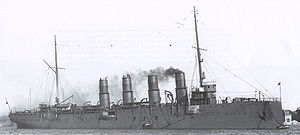French cruiser Châteaurenault (1898)

| |
| History | |
|---|---|
| Name | Châteaurenault |
| Namesake | François Louis de Rousselet, Marquis de Châteaurenault |
| Laid down | 12 October 1895 |
| Launched | 12 May 1898 |
| Commissioned | 10 October 1902 |
| Fate | Sunk by German submarine UC-38, 14 December 1917 |
| General characteristics | |
| Type | Cruiser |
| Displacement | 8,200 tonnes (8,070 long tons) |
| Length | 140 m (459 ft 4 in) |
| Beam | 18 m (59 ft 1 in) |
| Draught | 7.5 m (24 ft 7 in) |
| Installed power | 24,000 shp (17,897 kW) |
| Propulsion | du Temple-Normand small-tube boiler, direct-flame sub-version[1] |
| Speed | 24 knots (44 km/h; 28 mph) |
| Complement | 625 |
| Armament | list error: <br /> list (help) 2 × 164 mm (6.5 in) guns 6 × 138 mm (5.4 in) guns 10 × 47mm guns 5 × 37mm guns |
The Châteaurenault was a protected cruiser of the French Navy intended for commerce raiding. She was the first ship of the French Navy named in honour of François Louis de Rousselet, Marquis de Châteaurenault.
Launched on 24 March 1898, Châteaurenault was commissioned in October.
In 1904, she was damaged after accidentally running into an underwater rock.
In 1910, she ran aground on Spartel, and had to be taken in tow by the Victor Hugo.
From 1913, she was used as a schoolship in Toulon.
Recommissioned at the outbreak of the First World War, Châteaurenault patrolled the Mediterranean. In 1917, she was used as a troopship, ferrying soldiers from Taranto to Itea. On 5 October, she rescued survivors of the liner SS Gallia, torpedoed by U-35, and saved 1,200 men.
Sinking
On 14 December 1917, at 38°15′N 20°22′E / 38.250°N 20.367°E, German U-boat UC-38, commanded by Hans Hermann Wendlandt,[2] met the convoy comprising Châteaurenault and her escorts Mameluck, Rouen and Lansquenet.[3] UC-38 approached and fired one torpedo at 06:47, striking Châteaurenault amidships. UC-38 then dived to 38 metres (125 ft), while the Mameluck and Rouen rushed to the launching position of the torpedo, and Lansquenet started picking up people thrown overboard by the explosion. Châteaurenault requested her escorts to close in and evacuate Army personnel, which was completed by 07:26. The trawler Balsamine came to the rescue and made attempts to take Châteaurenault in tow.[3]
Rising to periscope depth, UC-38 saw Châteaurenault still afloat, and fired a second torpedo, which hit at 8:20; Châteaurenault foundered quickly, though the surviving crew aboard were rescued. Lansquenet, in the process of picking up her launches, rushed to the launching point and dropping 7 depth charges. One caused a slight leak in the submarine; Wendlandt ordered a dive to bring his ship below the area targeted by the depth charges, but a false manœuvre made UC-38 climb instead, and a second explosion caused a large leak, forcing Wendlandt to surface and abandon ship.[2][3]
UC-38 surfaced briefly and was immediately targeted by the guns of Mameluck, which continued her attack by launching several depth charges. UC-38 surfaced again, and this time both Mameluck and Lansquenet opened fire, hitting her several times and killing several of her crew as they abandoned ship. She sank at 08:40, and the French destroyers picked up the survivors.[2][3]
German sources claim that 25 men were rescued and 9 killed; a sailor of UC-38 claimed that 20 men were saved out of a 28-man crew; French enquiry reports 20 rescued and 5 confirmed dead out of a 27-man crew.[2] From Châteaurenault 1,162 men were saved by Rouen, Mameluck and Lansquenet, and by a number of trawlers who had rushed to the scene, amounting to most of the personnel aboard. The victims were those killed by the initial explosion and the consecutive flooding of watertight compartments.[3]
References
- ^ Bertin, Louis-Émile (1906). Robertson, Leslie S. (ed.). Marine boilers, their construction and working, dealing more especially with tubulous boilers (2nd ed.). p. 435. Retrieved 28 March 2015.
- ^ a b c d "UC 38 Sous-marin". Pages d’Histoire: Forum Marine (in French). 2009. Retrieved 28 March 2015.
- ^ a b c d e "Chateaurenault". Pages d’Histoire: Forum Marine (in French). 2009. Retrieved 28 March 2015.
- Roche, Jean-Michel (2005). Dictionnaire des bâtiments de la flotte de guerre française de Colbert à nos jours, 1870-2006 (in French). Vol. Vol. II. Rezotel-Maury Millau. ISBN 9782952591713.
{{cite book}}:|volume=has extra text (help)
